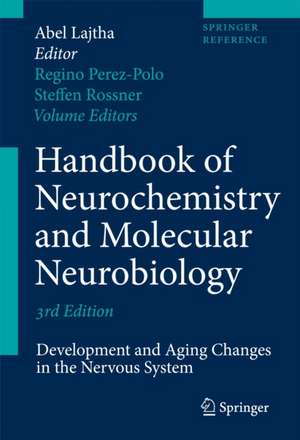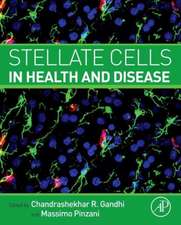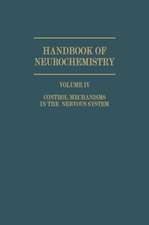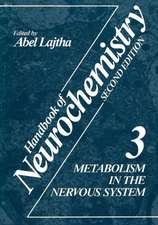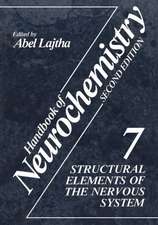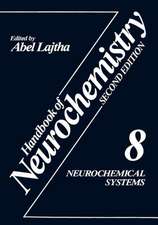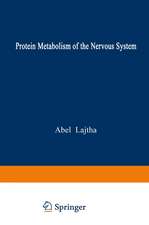Handbook of Neurochemistry and Molecular Neurobiology: Development and Aging Changes in the Nervous System
Abel Lajtha Editat de Regino Perez-Polo, Steffen Roßneren Limba Engleză Hardback – 5 iun 2008
Preț: 1382.65 lei
Preț vechi: 1686.16 lei
-18% Nou
Puncte Express: 2074
Preț estimativ în valută:
264.59€ • 274.68$ • 220.63£
264.59€ • 274.68$ • 220.63£
Carte tipărită la comandă
Livrare economică 22 martie-05 aprilie
Preluare comenzi: 021 569.72.76
Specificații
ISBN-13: 9780387326702
ISBN-10: 0387326707
Pagini: 324
Ilustrații: X, 324 p. 48 illus.
Dimensiuni: 165 x 240 x 19 mm
Greutate: 0.64 kg
Ediția:3rd ed. 2008
Editura: Springer Us
Colecția Springer
Locul publicării:New York, NY, United States
ISBN-10: 0387326707
Pagini: 324
Ilustrații: X, 324 p. 48 illus.
Dimensiuni: 165 x 240 x 19 mm
Greutate: 0.64 kg
Ediția:3rd ed. 2008
Editura: Springer Us
Colecția Springer
Locul publicării:New York, NY, United States
Public țintă
ResearchDescriere
Animals share the challenge of maintaining an internal environment that is restricted to fairly low ranges of temperature, pH, and water content within a well-protected envelope while engaged in continuous exchanges with the environment in terms of gases, liquids, energy, even as movement of body parts and the entire organism itself is necessary for survival. This dynamic spectrum of changes is further amplified during developmental events or more acutely during responses to pernicious environmental factors in due to trauma and disease. In addition, persistent incidents associated with aging can result in irreversible changes to the allostasis that characterizes the living condition.
In the nervous system, a very high metabolic turnover, fragile but steep ionic gradients, and morphological and structural constraints dictated by the necessity for prompt neuronal transmission of electrical impulses and necessary plasticity result in a highly fragile organ system.
Here we address a small sampling of major constituents of neural function at the cellular and molecular level that play important roles in development and aging, two endogenous processes that embody features of allostasis or the dynamic shifts in set points for specific homeostatic mechanisms associated with development and aging.
The opening chapters discuss the major players in the neurotrophic hypothesis, the neurotrophins. These growth factors have been shown to play a significant role during development and in the maintenance of the adult cholinergic system in CNS as well as in the development of the sensory and sympathetic nervous system. That they are also involved in plasticity events associated with memory and behavior points to the degenerate nature of signaling molecules that archive specificity by acting in concert as part of ensembles of molecules rather than solitary regulators.
It is widely known that oligodendroglia and myelination events are late arrivals in the developmental scheme of the brain and are also prime targets in early development of ischemic insults. Thus, a chapter on oligodendroglia and myelination in development and aging serves to introduce these nonneuronal partners vital to proper neuronal transmission. Molecular participants in stress responses to both acute and chronic stressors are discussed from different perspectives in following chapters with varying degrees of emphasis on injury versus normal aging and neurodegenerative disease.
The study of neural responses to stress of various kinds has led to a realization of the importance of plasticity and the complexity of the mechanism allowing plasticity in the nervous system. The chapters addressing the topic are followed by an introduction to the amyloid hypothesis, and what may be its central character the enzyme held mostly responsible for the generation of beta amyloid. This if followed by a broader discussion of misfolding proteins in the nervous system and its possible interventions to counteract aging-associated deficits.
Limited in scope but offering a broad sampling, these chapters stress the dynamic features of neuronal responses to internal (developmental) cues or the more harmful external events (injury and disease) in a modern perspective.
In the nervous system, a very high metabolic turnover, fragile but steep ionic gradients, and morphological and structural constraints dictated by the necessity for prompt neuronal transmission of electrical impulses and necessary plasticity result in a highly fragile organ system.
Here we address a small sampling of major constituents of neural function at the cellular and molecular level that play important roles in development and aging, two endogenous processes that embody features of allostasis or the dynamic shifts in set points for specific homeostatic mechanisms associated with development and aging.
The opening chapters discuss the major players in the neurotrophic hypothesis, the neurotrophins. These growth factors have been shown to play a significant role during development and in the maintenance of the adult cholinergic system in CNS as well as in the development of the sensory and sympathetic nervous system. That they are also involved in plasticity events associated with memory and behavior points to the degenerate nature of signaling molecules that archive specificity by acting in concert as part of ensembles of molecules rather than solitary regulators.
It is widely known that oligodendroglia and myelination events are late arrivals in the developmental scheme of the brain and are also prime targets in early development of ischemic insults. Thus, a chapter on oligodendroglia and myelination in development and aging serves to introduce these nonneuronal partners vital to proper neuronal transmission. Molecular participants in stress responses to both acute and chronic stressors are discussed from different perspectives in following chapters with varying degrees of emphasis on injury versus normal aging and neurodegenerative disease.
The study of neural responses to stress of various kinds has led to a realization of the importance of plasticity and the complexity of the mechanism allowing plasticity in the nervous system. The chapters addressing the topic are followed by an introduction to the amyloid hypothesis, and what may be its central character the enzyme held mostly responsible for the generation of beta amyloid. This if followed by a broader discussion of misfolding proteins in the nervous system and its possible interventions to counteract aging-associated deficits.
Limited in scope but offering a broad sampling, these chapters stress the dynamic features of neuronal responses to internal (developmental) cues or the more harmful external events (injury and disease) in a modern perspective.
Cuprins
NEUROTROPHINS AND CENTRAL NERVOUS SYSTEM DEVELOPMENT – D. B. Pereira and M. V. Chao.- NERVE GROWTH FACTOR REGULATED GENE EXPRESSION – L. A. Greene and J. M. Angelastro.- MYELINATING CELLS IN THE CENTRAL NERVOUS SYSTEM—DEVELOPMENT, AGING, AND DISEASE – J. Neman and J. de Vellis.- SULFUR-CONTAINING AMINO ACIDS IN THE CNS: HOMOCYSTEINE – D. K. Rassin.- STRESS RESPONSE SIGNAL TRANSDUCTION – X. Hu and J. R. Perez-Polo.- AGING AND OXIDATIVE STRESS RESPONSE IN THE CNS – V. Calabrese, D. A. Butterfield, and A. M. G. Stella.- PARALLELS BETWEEN NEURODEVELOPMENT AND NEURODEGENERATION: A CASE STUDY OF ALZHEIMER’S DISEASE – X. Zhu, G. Casadesus, K. M. Webber, C. S. Atwood, R. L. Bowen, G. Perry, and M. A. Smith.- DIFFERENTIATION AND DE-DIFFERENTIATION—NEURONAL CELL-CYCLE REGULATION DURING DEVELOPMENT AND AGE-RELATED NEURODEGENERATIVE DISORDERS – T. Arendt.- mRNA MODULATIONS IN STRESS AND AGING – E. Meshorer and H. Soreq.- MOLECULAR MECHANISMS OF DENDRITIC SPINE PLASTICITY IN DEVELOPMENT AND AGING – M. R. Kreutz, I. König, M. Mikhaylova, C. Spilker, and W. Zuschratter.- ALZHEIMER’S DISEASE BACE PROTEASES – S. Roßner and S. F. Lichtenthaler.- PROTEIN MISFOLDING, A COMMON MECHANISM IN THE PATHOGENESIS OF NEURODEGENERATIVE DISEASES – L. Vergara, K. Abid, and C. Soto.- ANTI-AGING STRATEGIES – J. A. Joseph and J. R. Perez-Polo
Caracteristici
Addresses sampling of major elements of neural function at the cellular and molecular level that play important roles in development and aging
Stresses the dynamic features of neuronal responses to internal (developmental) cues and the more harmful external events (injury and disease)
Topics include neurotrophins, oligodendroglia, myelination, stress response, plasticity, misfolding proteins, and interventions to counteract aging-associated illness
Stresses the dynamic features of neuronal responses to internal (developmental) cues and the more harmful external events (injury and disease)
Topics include neurotrophins, oligodendroglia, myelination, stress response, plasticity, misfolding proteins, and interventions to counteract aging-associated illness
